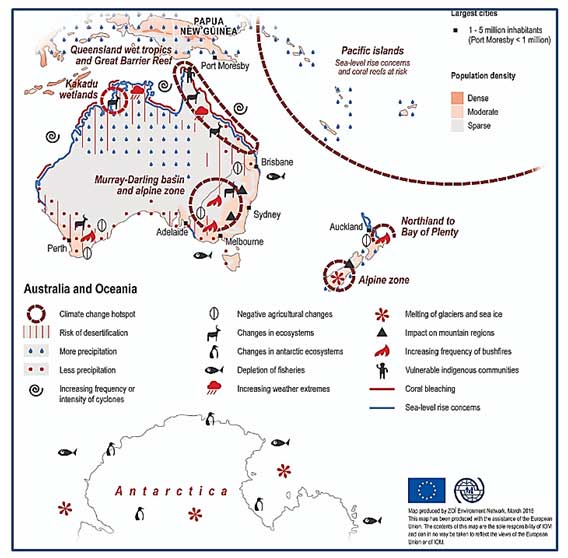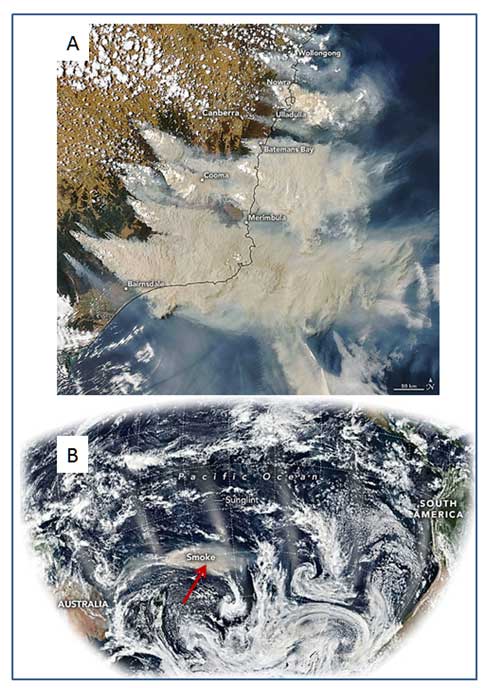Global warming and its disastrous consequences are now truly with us since the second part of 2019. At the moment a change in the weather has given parts of the country a respite from the raging fires, some of which are still burning or smoldering, waiting for another warm spell to flare up. The danger zones include the Australian Capital Territory, from where these lines are written. To date 18.6 million hectares(186,000 square kilometers) were burnt, including native forests, native animals, homesteads and towns, and 24 people died. The firestorms betray harbingers of a planetary future, or a lack of such,under ever rising temperatures and extreme weather events inherent in fossil fuel driven global warming.
Global heating
As the atmospheric concentration of the well-mixed greenhouse gases rise (CO2>411.76 ppm;CH4>1870.5 ppb; N2O>333 ppb plus trace greenhouse gases) land temperatures soar (NASA global sea-land mean of1.05C since 1880). According to Berkeley Earth global land temperatures have increased by 1.5C over the past 250 years and mean Arctic temperatures have risen by 2.5C to 3.0C between 1900 and 2017.According to NASA:
- “Extreme heatwaves will become widespread at 1.5 degrees Celsius warming. Most land regions will see more hot days, especially in the tropics.
- At 1.5C about 14 percent of Earth’s population will be exposed to severe heatwaves at least once every five years, while at 2 degrees Celsius warming that number jumps to 37 percent”
- “Risks from forest fires, extreme weather events and invasive species are higher at 2 degrees warming than at 1.5 degrees warming”
- “Ocean warming, acidification and more intense storms will cause coral reefs to decline by 70 to 90 percent at 1.5 degrees Celsius warming, becoming all but non-existent at 2 degrees warming.”

Figure 1. The distribution of global fires. NASA.
However, bar the transient masking effects of sulphur aerosols, which according to estimates by Hansen et al. (2011) induce more than 1.0C of cooling, global temperatures have already reached near 2.0C[1]. As aerosols are not homogeneously distributed, in some parts of the world temperatures have already soared to such levels. Thus the degree to which aerosols cool the earth, which depends on aerosol particle size range, has been grossly underestimated.
The rate of global warming, at ~2 to 3 ppm year and ~1.5C in about one century, faster by an order of magnitude then geological climate catastrophe such as the PETM and the KT impact, has taken scientists by surprise, requiring a change from the term climate change to climatecalamity.
The Australian firestorms
In Australia mean temperatures have risen by 1.5C between 1910 and 2019 (Figure 2), as a combination of global warming and the ENSO conditions, as reported by the Bureau of Meteorology.
“The Indian Ocean Dipole (IOD) has returned to neutral after one of the strongest positive IOD events to impact Australia in recent history … the IOD’s legacy of widespread warm and dry conditions during the second half of 2019 primed the Australian landscape for bushfire weather and heatwaves this summer. In the Pacific Ocean, although indicators of the El Niño–Southern Oscillation (ENSO) are neutral, the tropical ocean near and to the west of the Date Line remains warmer than average, potentially drawing some moisture away from Australia.”

Figure 2. (A) Australian temperatures; (B) severe fire weather; (C) drought; (D) driest year.Bureau of Meteorology.
The prolonged drought (Figure 1 C, D),low fuel moisture, high temperatures (Figure 2A) and warm winds emanating from the inland have rendered large parts of the Australian continent tinder dry, creating severe fire weather (Figure 2B) subject to ignition by lightning and human factors. Fires on a large scale create their own weather (Figure 4). Observations of major conflagrations, including the 2003 Canberra fires, indicate fires can form atmospheric plumes which can migrate and as hot plumes radiating toward the ground (Figure 4C).
The underlying factor for rising temperatures and increasingly severe droughts in Australia is the polar-ward shift in climate zones(Figure 3) as the Earth warms, estimated as approximately56-111 km per decade, where dry hot subtropical zones encroach into temperate zones, as is also the case in South Africa and the Sahara.

Figure 3. Drying parts of southern Australia, including Western Australia, South Australia and parts of the eastern States, accompanied with increasing bushfires. The blue dots represent more precipitation and the red dots lesser precipitation. The vertical purple lines represent risk of desertification and the purple rings climate change hot spots.

Figure 4. The Australian bushfires (A) A bushfire rages in Mount Adrah, Australia.(B) Australia fire storm; (C) fire tornado, Kangaroo Island

Figure 5 (A) Smoke emanating from the southeastern Australian fires; (B) smoke from the pyro-cumulonimbus clouds of the Australian fires drifting across the Pacific Ocean. The fire clouds have lofted smoke to unusual heights in the atmosphere. The CALIPSO satellite observed smoke soaring between 15 to 19 kilometers on January 6, 2020—high enough to reach the stratosphere.NASA.
Smoke signals emanating from the Australian fires are now circling around the globe (Figure 5) signaling awarning of the future state of Earth should Homo sapiens, so called, not wake up to the consequences of its actions.
(Dr) Andrew Glikson, Earth and climate scientist, Australian National University
[1]By analogy to the requirementfor a patient’s body temperature to be measuredbefore andnot after aspirin has been taken.
SIGN UP FOR COUNTERCURRENTS DAILY NEWS LETTER











































